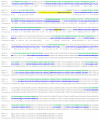Characterization of Hemagglutinin Negative Botulinum Progenitor Toxins
- PMID: 28617306
- PMCID: PMC5488043
- DOI: 10.3390/toxins9060193
Characterization of Hemagglutinin Negative Botulinum Progenitor Toxins
Abstract
Botulism is a disease involving intoxication with botulinum neurotoxins (BoNTs), toxic proteins produced by Clostridium botulinum and other clostridia. The 150 kDa neurotoxin is produced in conjunction with other proteins to form the botulinum progenitor toxin complex (PTC), alternating in size from 300 kDa to 500 kDa. These progenitor complexes can be classified into hemagglutinin positive or hemagglutinin negative, depending on the ability of some of the neurotoxin-associated proteins (NAPs) to cause hemagglutination. The hemagglutinin positive progenitor toxin complex consists of BoNT, nontoxic non-hemagglutinin (NTNH), and three hemagglutinin proteins; HA-70, HA-33, and HA-17. Hemagglutinin negative progenitor toxin complexes contain BoNT and NTNH as the minimally functional PTC (M-PTC), but not the three hemagglutinin proteins. Interestingly, the genome of hemagglutinin negative progenitor toxin complexes comprises open reading frames (orfs) which encode for three proteins, but the existence of these proteins has not yet been extensively demonstrated. In this work, we demonstrate that these three proteins exist and form part of the PTC for hemagglutinin negative complexes. Several hemagglutinin negative strains producing BoNT/A, /E, and /F were found to contain the three open reading frame proteins. Additionally, several BoNT/A-containing bivalent strains were examined, and NAPs from both genes, including the open reading frame proteins, were associated with BoNT/A. The open reading frame encoded proteins are more easily removed from the botulinum complex than the hemagglutinin proteins, but are present in several BoNT/A and /F toxin preparations. These are not easily removed from the BoNT/E complex, however, and are present even in commercially-available purified BoNT/E complex.
Keywords: botulinum neurotoxin; botulism; protein toxin; proteomics; toxin complex.
Conflict of interest statement
The authors declare no conflict of interest.
Figures




Similar articles
-
Molecular characterization of the clusters of genes encoding the botulinum neurotoxin complex in clostridium botulinum (Clostridium argentinense) type G and nonproteolytic Clostridium botulinum type B.Curr Microbiol. 1997 Oct;35(4):207-14. doi: 10.1007/s002849900240. Curr Microbiol. 1997. PMID: 9290060
-
Detection of the HA-33 protein in botulinum neurotoxin type G complex by mass spectrometry.BMC Microbiol. 2015 Oct 23;15:227. doi: 10.1186/s12866-015-0567-5. BMC Microbiol. 2015. PMID: 26494251 Free PMC article.
-
Complete DNA sequences of the botulinum neurotoxin complex of Clostridium botulinum type A-Hall (Allergan) strain.Gene. 2003 Oct 2;315:21-32. doi: 10.1016/s0378-1119(03)00792-3. Gene. 2003. PMID: 14557061
-
Assembly and function of the botulinum neurotoxin progenitor complex.Curr Top Microbiol Immunol. 2013;364:21-44. doi: 10.1007/978-3-642-33570-9_2. Curr Top Microbiol Immunol. 2013. PMID: 23239347 Free PMC article. Review.
-
[Clostridium botulinum and botulinum neurotoxin].Brain Nerve. 2011 Jul;63(7):755-61. Brain Nerve. 2011. PMID: 21747146 Review. Japanese.
Cited by
-
The Distinctive Evolution of orfX Clostridium parabotulinum Strains and Their Botulinum Neurotoxin Type A and F Gene Clusters Is Influenced by Environmental Factors and Gene Interactions via Mobile Genetic Elements.Front Microbiol. 2021 Feb 26;12:566908. doi: 10.3389/fmicb.2021.566908. eCollection 2021. Front Microbiol. 2021. PMID: 33716993 Free PMC article.
-
Validation of a clinical assay for botulinum neurotoxins through mass spectrometric detection.J Clin Microbiol. 2024 Jun 12;62(6):e0162923. doi: 10.1128/jcm.01629-23. Epub 2024 Apr 30. J Clin Microbiol. 2024. PMID: 38687021 Free PMC article.
-
Crystal structures of OrfX1, OrfX2 and the OrfX1-OrfX3 complex from the orfX gene cluster of botulinum neurotoxin E1.FEBS Lett. 2023 Feb;597(4):524-537. doi: 10.1002/1873-3468.14576. Epub 2023 Jan 27. FEBS Lett. 2023. PMID: 36653893 Free PMC article.
-
Looking for the X Factor in Bacterial Pathogenesis: Association of orfX-p47 Gene Clusters with Toxin Genes in Clostridial and Non-Clostridial Bacterial Species.Toxins (Basel). 2019 Dec 31;12(1):19. doi: 10.3390/toxins12010019. Toxins (Basel). 2019. PMID: 31906154 Free PMC article.
-
Clostridial Neurotoxins: Structure, Function and Implications to Other Bacterial Toxins.Microorganisms. 2021 Oct 23;9(11):2206. doi: 10.3390/microorganisms9112206. Microorganisms. 2021. PMID: 34835332 Free PMC article. Review.
References
-
- Fujinaga Y., Inoue K., Nomura T., Sasaki J., Marvaud J.C., Popoff M.R., Kozaki S., Oguma K. Identification and characterization of functional subunits of Clostridium botulinum type A progenitor toxin involved in binding to intestinal microvilli and erythrocytes. FEBS Lett. 2000;467:179–183. doi: 10.1016/S0014-5793(00)01147-9. - DOI - PubMed
MeSH terms
Substances
LinkOut - more resources
Full Text Sources
Other Literature Sources

